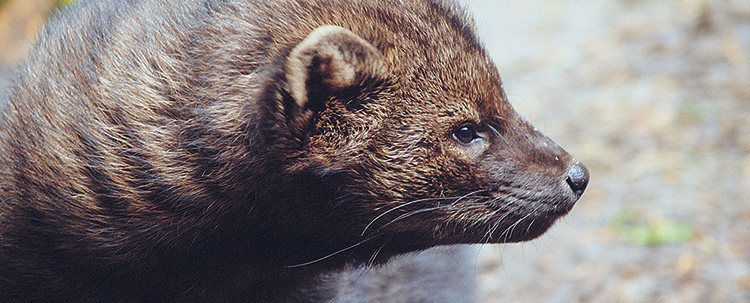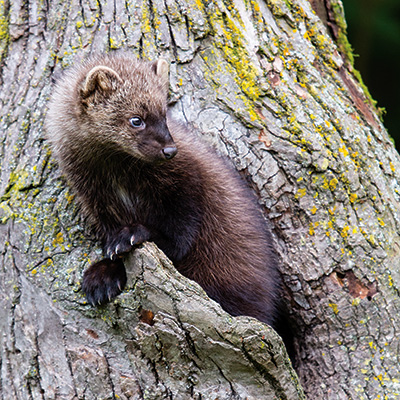A Story of Mammals in Alberta’s Beaver Hills Biosphere Reserve

BY FRANCES STEWART
I was walking through an aspen forest in the UNESCO Beaver Hills Biosphere Reserve (BHB), 50 km east of Edmonton and south of Elk Island National Park. The first rays of sunlight were peeking through the trees and shining off the fresh snow on this crisp January morning. It was silent, still. I could see my breath shimmering in front of me like the beautiful hoar frost on the surrounding branches. A perfect morning for live-trapping fisher.
I approached one of the 25 traps I’d set the night before as part of my Ph.D. research. There was a small scuffle, some breath rising from the protective branches I’d placed on top of the trap, and a quiet “chortle” sound coming from within. Bingo. I’d caught another fisher.
The last fisher trap I walked up to was on a Nature Conservancy parcel of land, donated by a private landowner, and nestled between two provincial protected areas. My veterinarian and I peeked inside the trap. Score! It was a fisher that we had not yet collared. I could deploy my last collar and collect my final batch of data. Luck goes a long way in wildlife research.
We went through our approved protocol for putting a GPS collar on this animal. While handling a fisher you get a rare glimpse into the life of this incredibly elusive, strong and free creature. They are roughly the size of a house cat – this female was 2.2 kg and males can be up to 7 kg. Their coat is luxurious, thick, rich and warm. Surprisingly, fishers smell beautiful; rich, earthy and with a slightly musky odour that I associate with cinnamon. Working with these animals gave me a personal and broader scientific perspective of how another species may use the landscapes we all call home.
After placing on the collar, we released the female fisher and watched her dart quickly and gracefully through the snow and away under the wild roses that thickly covered the ground. Her movements would illustrate the most important parts of the BHB for maintaining mammals. Her DNA would tell us the story of where she came from and how her ancestors got to the BHB. Her camera trap photos let us know how she contributed to the general wildlife assemblage of this landscape, and more broadly, to how humans affect the persistence of mammals on similar landscapes globally.
We silently packed up our fisher trapping kit, hopped in the car and I made a final check that all my notes and forms were complete. Back to our field base we went, with thoughts of fresh fisher tracks in the bright morning snow and what they might tell us about maintaining biodiversity in each of our own backyards. It was time for a warm beverage.
Understanding How We Affect the Wildlife in Our Own Backyards and Beyond
The Beaver Hills UNESCO Biosphere Reserve (BHB) is a landscape of both natural beauty and human use. Some parts of the BHB are fully protected, others are partially protected, and some are used for agricultural production. Its defining feature is a glacial moraine that has maintained many of its natural components. The BHB lies at the junction of Canada’s boreal forest and aspen parkland ecozones and is composed of coniferous and aspen forest, patches of natural grasslands, and various types of wetlands. This complex mosaic of habitat types supports a high diversity of wildlife.
The Beaver Hills Biosphere Reserve Association (formerly the Beaver Hills Initiative) is a multi-stakeholder entity that aims to conserve the biodiversity within the various parks and recreation areas in the BHB as well as in the embedded agricultural lands. This initiative brings together the many stakeholders of the area including local landowners, environmental non-government organizations, all levels of government and industry. These stakeholders have different perspectives, but the collective aim is to maintain the ecological integrity of this important landscape.
In collaboration with the BHB, my research goal was to broaden the scientific understanding of how our collective actions affect biodiversity and the role conservation efforts play. The mammals within the BHB provided a perfect study system. Mammals are charismatic, so people generally want to get involved in the research, and they are wide ranging, so understanding one portion of their range can provide inferences for other areas as well. Finally, the BHB was a tractable size for a time-limited Ph.D. program.
With the support of my team, I began by setting up 64 wildlife cameras across the study area. This provided a survey of the mammals that roamed the BHB – the variety of species present, their spatial distribution and the frequency of sightings. We also installed a non-invasive hair snagging device that provided samples for genetic analysis of fishers. Fishers were the specific target of the genetic work because they had been reintroduced to the BHB in the 1990s, after being extirpated early in the 20th century. I wanted to know if these fishers remained as an isolated population, or whether fishers from healthy populations in northern Alberta had moved into the BHB. This would help us better understand how biodiversity is shared between these two regions.
I found that fishers in the BHB are not as isolated as previously supposed. There is, in fact, a lot of genetic similarity between fishers from northern Alberta and from the BHB. Individuals must have been moving and interbreeding regularly over the last few decades to be so closely related.1 It appears that the BHB is functionally connected to biodiversity in other regions of the province.
Next, I wanted to understand how the movement patterns of fishers within these landscapes were affected by human land uses as well as by conservation practices. Fortunately, the fisher trapping had been going well. Trapping fisher is notoriously difficult, but I was lucky. I was getting two, even three animals some nights! The GPS collars I put on animals were the most advanced of their kind; incredibly light weight, sleek and able to take a GPS position once every five minutes. I combined these animal movement paths with landscape information – essentially overlaying the tracked routes on a GoogleEarth™ map – to understand how fishers were piecing together the BHB. What I saw was that fishers consistently moved within forested areas and avoided open areas or areas of industrial use. Whether the sites were privately owned land or within a protected area did not matter; it was the type of landscape, not the type of protection, that mattered most.2
At this point, I knew a lot about fishers on the BHB. But what about the other mammal species? How were they affected by different forms of land use? And what could be done to ensure these species remained viable? I used the camera trap photos to investigate these questions. Again, by placing these photos in a GoogleEarth-type map, I could draw associations between specific species and the types of land-use features on the BHB (natural, industrial, agricultural and/or some form of protection).
I found that mammals on the BHB were clustered close to natural features – features that existed before human settlement (e.g., forest, natural grasslands, shrub areas and wetlands). Mammals generally avoided areas of human land use. Interestingly, as with the fisher movement results, this was not limited to sites designated as protected. The backyard of a private landowner was just as valuable at hosting the BHB’s wildlife as many of the protected areas and conservation areas, as long as it contained natural features.3 The upshot is that natural features on privately owned land play an important role in maintaining biodiversity. These areas compliment the support provided by areas of formal protection.
The findings of my research have important management implications. Small fragments of natural landscape features are important for animals to piece together the resources they need to survive – whether within an official protected area or on privately owned land. My work will help conservation organizations identify the best sites for biodiversity conservation on the BHB. For example, the Nature Conservancy of Canada has initiated a program to protect high conservation value areas in the BHB through conservation easements and land purchases, and to promote the stewardship of the entire region. Such efforts will ensure that the functional integrity of the landscape is maintained, and that the biodiversity of this region is conserved for our children and grandchildren to enjoy.
References
1 Stewart, F.E.C., Volpe, J.P., Taylor, J.S., Bowman, J., Thomas, P.J., Pybus, M.J. and Fisher, J.T., 2017. Distinguishing reintroduction from recolonization with genetic testing. Biological conservation, 214, pp.242-249.
2 Stewart, F.E.C., Darlington, S., Volpe, J.P., McAdie, M. and Fisher, J.T., 2019. Corridors best facilitate functional connectivity across a protected area network. Scientific reports, 9(1), pp.1-9.
3 Stewart, F.E.C., Volpe, J.P., Eaton, B., Hood, G., Vujnovic, D., and Fisher, J.T., 2019. Protected areas alone rarely predict mammal biodiversity across spatial scales in an Alberta working landscape. Biological conservation, in press.
Dr. Frances Stewart completed her Ph.D. in 2018. The work was very much a combined Albertan effort involving collaboration between diverse stakeholders living across the BHB. She enjoys communicating the outcome of this research with all individuals involved and interested. Project reports, publications and updates are available at https://mesocarnivore.weebly.com/
This article originally ran in Nature Alberta Magazine - Winter 2020, Volume 49 | Number 4
